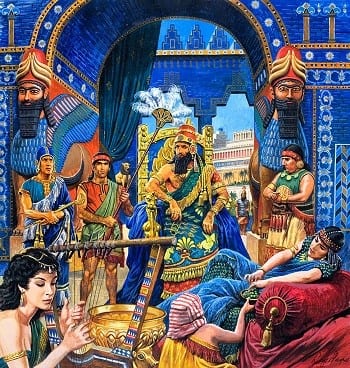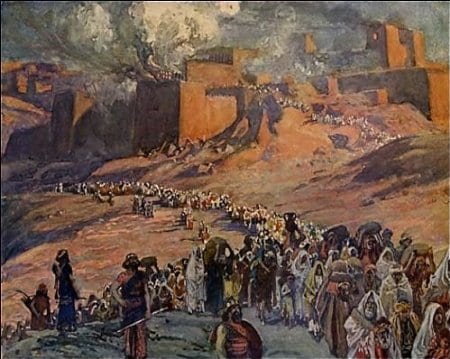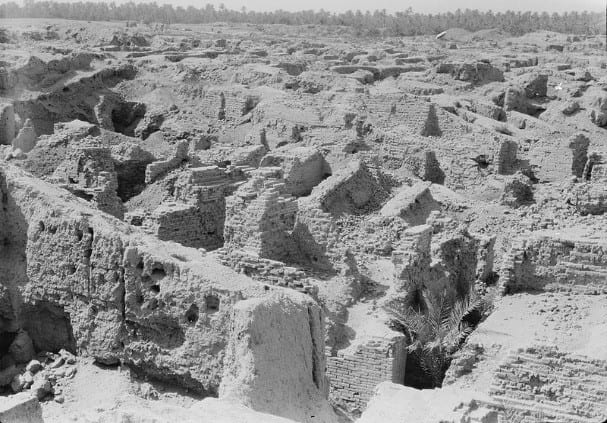Introduction
Babylon was a major city of ancient Mesopotamia in the fertile plain between the Tigris and Euphrates rivers. The city was built upon the Euphrates and divided in equal parts along its left and right banks, with steep embankments to contain the river’s seasonal floods. The Bible ascribes the founding of Babylon to the descendants of Cush and the followers of Nimrod[1]and it is where the infamous Tower of Babel was built and where God had confused the languages.[2]
The city reached the height of its glory during the reign of Nebuchadnezzar (605-562 BC). Its grandeur can be gleaned from a report from the Greek historian Herodotus who visited it after the conquest by Cyrus and while much of its original splendor was still preserved. He wrote that Babylon was in the form of a great square 90 km (56 miles) in length and the city itself, was  encased by a large wall, high and wide enough for a four- horse chariot to turn around, when travelling along its top. The wall contained 100 gates; 25 on each side, all with bronze-plated doors. All construction was of clay bricks and the streets were laid out in an orderly fashion. Some houses were three and four stories high. A large bridge joined the two halves of the city.[3]
encased by a large wall, high and wide enough for a four- horse chariot to turn around, when travelling along its top. The wall contained 100 gates; 25 on each side, all with bronze-plated doors. All construction was of clay bricks and the streets were laid out in an orderly fashion. Some houses were three and four stories high. A large bridge joined the two halves of the city.[3]
Its hanging gardens were one of the Seven Wonders of the Ancient Word as listed by Hellenic culture. Contemporary commentators state that it was the largest city in the world of its day.
The painting is of Nebuchadnezzar at the blue-tiled Ishtar Gate which was the northern entrance to Babylon. It was named after their goddess of love and war. Bulls and dragons, symbols of the god Marduk, decorated the gate.
God’s use of the Babylonians to punish Judah
The last four kings of Judah rejected God and sought foreign gods and idols to worship and led the people this way. In fact, the minor prophet Habakkuk asked God when is He going to punish the people for all of the violence and injustice he saw around him. God reveals to Habakkuk that He is going to use the Babylonians as His instrument of punishment. This causes a problem for Habakkuk because the Babylonians are worse than his own people. God tells him that He will destroy the Babylonians as well.[4]
 In line with God’s revelation, the Babylonian king Nebuchadnezzar attacked Jerusalem three times in the years; 605, 597 and finally with the destruction of the temple in 586 BC. Daniel was taken captive along with many other people in the first attack and remained in the land until Cyrus became king.[5] Ezekiel was taken captive in the second attack. Jeremiah recorded and also stated in a letter which he sent to the exiles in Babylon of the 597 attack; that this is God’s punishment on the people for rejecting Him and worshiping false gods. The letter stated also, that the exile will only last 70 years and then He will bring them back to Jerusalem.[6] Amazingly, 150 years before the event, Isaiah wrote that the king of the Medes whose name will be Cyrus[7] will allow the people to return to Jerusalem.[8]
In line with God’s revelation, the Babylonian king Nebuchadnezzar attacked Jerusalem three times in the years; 605, 597 and finally with the destruction of the temple in 586 BC. Daniel was taken captive along with many other people in the first attack and remained in the land until Cyrus became king.[5] Ezekiel was taken captive in the second attack. Jeremiah recorded and also stated in a letter which he sent to the exiles in Babylon of the 597 attack; that this is God’s punishment on the people for rejecting Him and worshiping false gods. The letter stated also, that the exile will only last 70 years and then He will bring them back to Jerusalem.[6] Amazingly, 150 years before the event, Isaiah wrote that the king of the Medes whose name will be Cyrus[7] will allow the people to return to Jerusalem.[8]
Many years after being taken into captivity, Daniel while reading the scroll of Jeremiah, comes across his prophecy of the exile being only for 70 years and Daniel realizes that the 70 years is almost up.[9] In fact true to prophecy, Cyrus issued the decree for the Jews to return in his first year as king[10] and the first lot left under the leadership of Zerubbabel in 536 BC,[11] which was 70 years from the first deportation of 605 BC.
Prophecies against Babylon
In the Bible, Babylon is seen as a place of great wickedness and is used in the Revelation symbolically as a system opposed to God. Isaiah condemns Babylon for its many gods in chapter 46 and in chapters 13 and 47 he announces its destruction:
And so Babylon, the most glorious of kingdoms, the flower of Chaldean culture, will be as utterly destroyed as Sodom and Gomorrah were when God sent fire from heaven; Babylon will never rise again. Generation after generation will come and go, but the land will never again be lived in. The nomads will not even camp there. The shepherds won’t let their sheep stay overnight.[12]
Isaiah[13] wrote in about 700 BC and Jeremiah[14] foretold between 626 and 586 BC, that it would be completely and utterly destroyed. Both prophets went as far as naming the Medes as her conquerors. Also, unlike many other biblical cities, Babylon would never be inhabited again, so complete will be her eventual destruction.
 Babylon fell to Cyrus the Great in 539 BC, but the city still persisted and was captured by Alexander the Great in 331 BC. After Alexander’s untimely death, a power struggle among his generals ensued and Babylon passed to the Seleucid dynasty in 312 BC. The city’s importance was greatly reduced by the building of a new capital on the Tigris, called Seleucia. Babylon fell into disuse and this photo taken in 1932, shows its utter destruction. It was not until the early 19th century that the remains of this once mighty city were discovered and excavated.
Babylon fell to Cyrus the Great in 539 BC, but the city still persisted and was captured by Alexander the Great in 331 BC. After Alexander’s untimely death, a power struggle among his generals ensued and Babylon passed to the Seleucid dynasty in 312 BC. The city’s importance was greatly reduced by the building of a new capital on the Tigris, called Seleucia. Babylon fell into disuse and this photo taken in 1932, shows its utter destruction. It was not until the early 19th century that the remains of this once mighty city were discovered and excavated.
Prophecy Fulfillment
The prophecies concerning Babylon were very specific and were completely fulfilled.
- Even though it was the world power at the time, it would be captured by the Medes. This was prophesied by Isaiah 150 years before it happened and by Jeremiah about 60 years before hand when Babylon was at the height of its power and quite possibly the largest city in the then known world.
- The man leading the attack and its capture would be Cyrus. Again, told by Isaiah 150 years before it happened and it would be Cyrus who would allow the people to return to Jerusalem.
- Jeremiah accurately predicted that the exile would only last 70 years, 60 years before the first returnees.
- Isaiah, Jeremiah and Habakkuk all stated that Babylon would be utterly destroyed well before it happened.
Conclusion
The Greek historian Herodotus who visited Babylon at the height of its glory wrote of its size and splendor. Yet, it comprised people who reject God and worshiped idols; it was known for its decadence and depravity. The Lord speaking through Isaiah and Jeremiah in particular, and Habakkuk as well, said it would be completely obliterated and never rebuilt. These prophecies were fulfilled to the letter. The remnant of this once great city whose gardens were part of the seven Wonders of the Ancient World, was only unearthed in the nineteenth century, the 1932 photo bears testimony to the accuracy of prophecy.
[1] Genesis 10:8-10.
[2] Genesis 11:1-9.
[3] Wycliffe Bible Dictionary, Editors, Charles F Pfeiffer, Howard F Vos and John Rea, Hendrickson Publishers, 1998, pages 187-189.
[4] Habakkuk chapter 1.
[5] Daniel 1:21.
[6] Jeremiah 25:11; 29:1-23. See also, 2 Chronicles 36:20-23.
[7] Isaiah foresaw that the Medes would take over Babylon.
[8] Isaiah 44:28
[9] Daniel 9:1-2.
[10] Ezra 1:1.
[11] Ezra 2:2.
[12] Isaiah 13:19-20.
[13] Isaiah 13:20, 21: 1-10 and chapter 47.
[14] Jeremiah chapters 50 and 51:11, 28.


1 Comment. Leave new
What a clear testimony to the truth of Scripture. Thanks for posting.